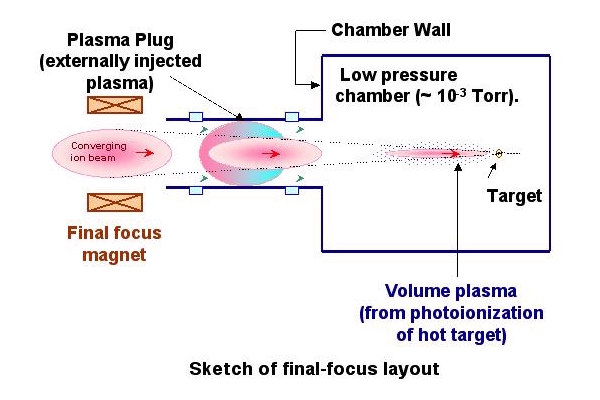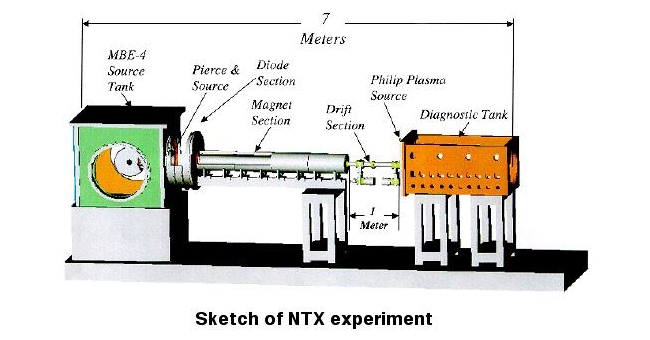Neutralized-Transport Experiment
 The Neutralized-Transport Experiment, or NTX, will
address many key scientific issues of final focus and
neutralized transport in a fusion chamber.
Numerical simulations indicate that the focal spot of a beam
on a fusion target is sensitive to aberrations in the final
magnetic lenses, the velocity spread within a beam,
charge-neutralization processes in the chamber, and in
particular, the beam perveance, loosely defined as the ratio
of the edge potential of a beam to its kinetic energy.
In NTX, a low-voltage and low-current beam with an adjustable
perveance will be used to test final-focus optics and charge
neutralization physics, providing the first experimental
validation of the computer codes and significantly enhancing
the science base for later final-focus designs. The
parameters of the experiment are chosen to ensure that
physics observed on NTX will model a full-scale transport
system as accurately as possible.
The Neutralized-Transport Experiment, or NTX, will
address many key scientific issues of final focus and
neutralized transport in a fusion chamber.
Numerical simulations indicate that the focal spot of a beam
on a fusion target is sensitive to aberrations in the final
magnetic lenses, the velocity spread within a beam,
charge-neutralization processes in the chamber, and in
particular, the beam perveance, loosely defined as the ratio
of the edge potential of a beam to its kinetic energy.
In NTX, a low-voltage and low-current beam with an adjustable
perveance will be used to test final-focus optics and charge
neutralization physics, providing the first experimental
validation of the computer codes and significantly enhancing
the science base for later final-focus designs. The
parameters of the experiment are chosen to ensure that
physics observed on NTX will model a full-scale transport
system as accurately as possible.
 As
currently conceived, the injector from the existing MBE-4
source will inject a 400 keV beam of singly charged potassium
ions into a magnetic lattice and plasma-filled drift
section. The source can produce a current up to
75 mA, so that the maximum perveance is 10-3,
almost an order of magnitude larger than that expected for a
fusion driver. After careful source
characterization, we will study the effects of
geometric aberrations in the final-focus magnets as a
function of beam perveance and convergence angle, and we will
test the feasibility of octupole corrections. This part
of the experimental program will also provide a test of
nonintercepting beam diagnostics. In the second phase
of the experiment, we will assess beam neutralization by a
plasma injected into the beam line and study beam stripping
by low-pressure gases in the drift section. A final set
of experiments will test beam neutralization by a plasma
injected near the end of the drift section, mocking up the
photoionized plasma produced by X-rays emitted by a heated
fusion target.
As
currently conceived, the injector from the existing MBE-4
source will inject a 400 keV beam of singly charged potassium
ions into a magnetic lattice and plasma-filled drift
section. The source can produce a current up to
75 mA, so that the maximum perveance is 10-3,
almost an order of magnitude larger than that expected for a
fusion driver. After careful source
characterization, we will study the effects of
geometric aberrations in the final-focus magnets as a
function of beam perveance and convergence angle, and we will
test the feasibility of octupole corrections. This part
of the experimental program will also provide a test of
nonintercepting beam diagnostics. In the second phase
of the experiment, we will assess beam neutralization by a
plasma injected into the beam line and study beam stripping
by low-pressure gases in the drift section. A final set
of experiments will test beam neutralization by a plasma
injected near the end of the drift section, mocking up the
photoionized plasma produced by X-rays emitted by a heated
fusion target.
The design of NTX components was begun in FY01, and we
expect that construction will be completed in
FY02. The pregram of investigating final-focus
questions and neutralized transport will be carried out
during the two following years.
For comments or questions contact WMSharp@lbl.gov or DPGrote@lbl.gov. Work described here was supported by the Office of Fusion Energy at the U.S. Department of Energy under contracts DE-AC03-76SF00098 and W-7405-ENG-48. This document was last revised June, 2002.
